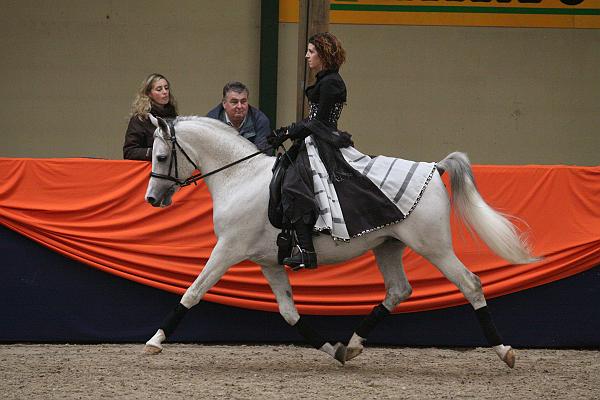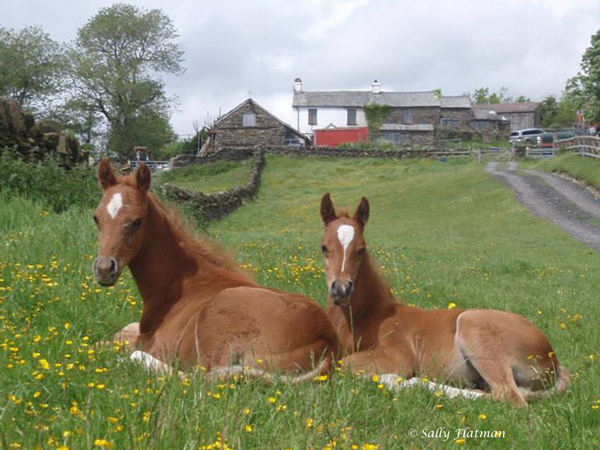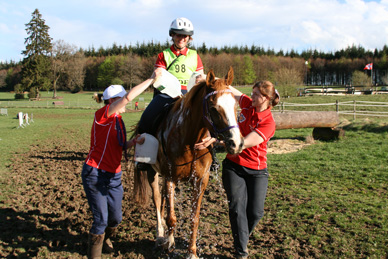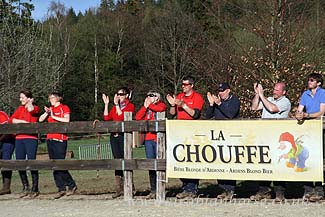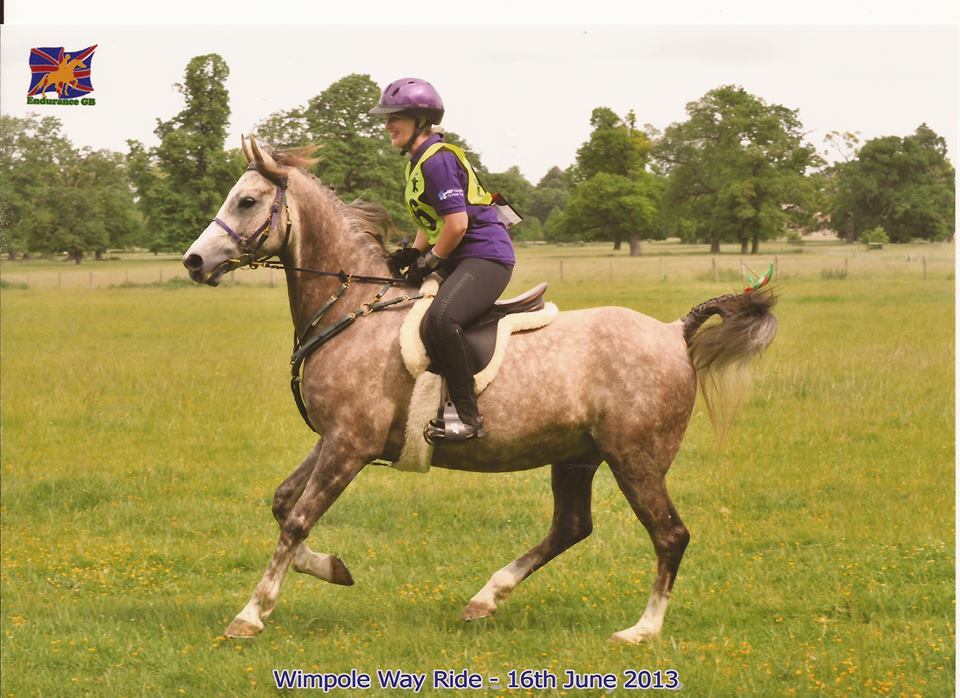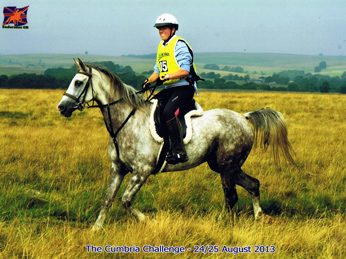As some of you visiting this page will know, Dom sadly passed away very suddenly and unexpectedly
in August 2018, and I have therefore had to deal with a significant change in my life and the workload with the animals. I am
continuing to care for a smaller number of horses and dogs, and I'm continuing the breeding programmes with both but at a
reduced capacity so I can manage things safely and sensibly going forward. Please bear with me in this time of transition and
adaptation into the new normal. Apologies for any broken links, missing images and out-of-date information on these pages,
which I am in the process of updating. Any questions in the meantime please email me at mail@arabianhorse.co.uk
and I'll get back to you when I can. Thanks for your understanding - Jan Atkinson
We are a small stud in the Lake
District, careful breeders of pure bred arab horses for our own endurance
ridden use for nearly 25 years. We know how few straight and high % Crabbet stallions at
public stud are left in the UK, and have expanded our breeding of pure Crabbet , GSB and Old English arabian foals at home and to visiting mares.
Our 100% Crabbet endurance stallion Hanson stood here until his death in
2009. He had just been joined here by Winged Saint, also straight Crabbet.
We now have Winged Saint's pure Crabbet 2013 successors to take his legacy into the future:
Seren Altair, a grandson of Hanson, and Seren Sadrh. Dandini our 2014
junior stallion, again "PC", has 2017 foals as well as pregnancies for 2018,
while Altair has a confirmed pregnancy in the only mare he has covered.
While the preservation of certain bloodlines is very high on our list of
aims, the overriding concern is that we produce young horses that are physically
and mentally suitable for top level competition, with endurance as our main
focus. We don't believe that good endurance horses are simply "the ones that are
not successful in other disciplines" or "are arabs therefore good at endurance".
We know what we are looking for in our breeding, both in the potential sires and
dams and in the offspring.
Fortunately, among the Crabbet population in the UK and around the world are some
eminently suitable horses for our purposes, which allows us to concentrate
heavily but not exclusively on preserving pure Crabbet bloodlines without
compromising our performance aims.
Another key area in our breeding aims is genetic health.
All of evolution is based on changes to genes. Changes that result in
improvement to the breed tend to be bred on to later generations, while changes
that result in major problems tend to result in gradual or rapid loss of the
resulting young animals. In between are changes that have small effects, or that have no
effect at all unless the young animal receives two copies of the gene, one from
each parent - "recessive" genes. Several of these genes, a tiny
fraction of the genetic makeup of many horses, cause health problems which are often specific to
particular breeds and their offspring. The ones that cause current concern in
arabian horses are all recessive, and require both parents to carry at least one copy
before they can cause any problems.
Huge advances in genetic
research have meant that the three significant defects that are known to be in the
arabian horse can now be identified simply and cheaply in the DNA of the horses by testing.
This allows breedings that could produce affected foals to be avoided. We
test all of our breeding horses for all three of these defective genes. This in
turn means that we can be sure that our foals are healthy, and that we can
select from the foals we have, keeping breeding stock that meet all of our
requirements AND are clear of those genetic defects even if their sire or dam
are not. By publishing the results, we can also inform owners of potential
breeding partners so that they are making choices based on reliable information instead
of blind hope.
This does not mean that youngstock carrying one or
more of these defective genes cannot be part of the breeding programme.
On the contrary, as long as they meet all of our other criteria, breeding
from them passes on all of the good characteristics and will produce a
statistical 50% of their own foals who are clear of the defect: preserving
all of the strengths and "filtering out" the one defective gene which will
not reappear in any of the offspring of those "clears". If a foal of a foal
does inherit the defect, the harmless situation is continued until the next
generation: a foal of a foal of a foal (and so on). Only when an
equally good, clear foal reaches maturity would we take the decision to drop
a carrier from the programme in favour of the clear - and even then it may
be perfectly sensible to keep the carrier in the programme too, on its
own merits.
Of course, many other breeds also have genetic problems, but we are not
concerned with them here.
As the economic uncertainty continues,
we feel that it is very important to
keep our programme of 100% Crabbet breeding going, and we would encourage everyone
to try to do so, too. With a small and aging global herd, the loss of a few
years as we all wait for the economy to pick up is having a disproportionate
effect on the future of 100% Crabbet breeding. We aim to keep our stud and livery
fees as low as we possibly can, and encourage mare owners to share transport
if possible.
There is of course a responsibility upon breeders to make
sure that the foals will have a secure future before they are bred, and we are
very happy to talk this through with potential breeders as well as all who get
beyond the stage of merely thinking about it.
This is the first year when we will not be welcoming
100% Crabbet, GSB ("General Stud Book") and OE ("Old English") mares for breeding lease arrangements.
We have reached the stage where we have to look at a gradual reduction in our
own breeding because of our own future age - to avoid needing to disperse a
large herd in 20 years' time because we can no longer cope.
We can thoroughly recommend breeding leases and
loans (which have been on either RIF/return-in-foal
or RNIF/return-not-in-foal terms). Each arrangement has its advantages in addition to the
preservation of bloodlines:
RIF gives the mare owner 18 to 20 months without her costs, plus a foal
without fees for stallion covering or livery. We could afford to have a foal
without the capital outlay and the long term outgoings of a mare we owned;
RNIF gives the mare owner
the same "cost holiday", without the practical and financial burdens of foaling
and a foal to bring on or to find a home for.
We have given another arrangement and motivation for breeding the rather catchy title
"AARNIF" (but of course it could also be AARIF or even
AAF!!!) (more to follow...)
Having changed the main emphasis of our breeding, from Crabbet/Polish to pure
and very high percentage Crabbet, we have never achieved what some others have:
a distinctive lineage over generations. Instead we have concentrated on two
themes: staying as few generations from horses foaled at Crabbet Park as we
can and staying true to the type of horse we so admire.
Thus Hanson, and then Halal: both of their parents, Hanif and Sherilla, were
foaled and bred from at Crabbet; Shadowed Gold, daughter of St. John; Silver
Ingot; Silihah; and Winter Queen who is GSB and over 90% Crabbet. All of these epitomise
the powerful, versatile physical horse with the temperament and intelligence
that we insist on, the sort of horse we should
be breeding from.
Once we admit to the limitations of our own age, we will
probably reduce our Crabbet breeding contribution to a herd of stallions for
public stud, each with all of the characteristics we want, and offering a wide
choice of pure Crabbet bloodlines for visiting mares.
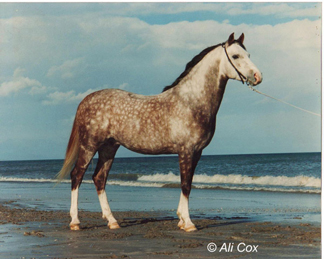
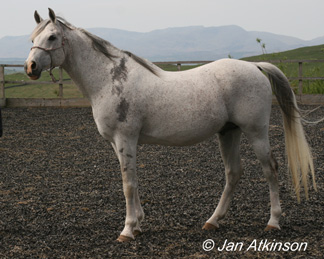
Return to Top
Equine Ethology: towards a natural
existence for our horses
The way we keep all of
our horses allows us to teach courses in equine
ethology, equine behaviour and welfare, and also means that they are ideal for Equine
Assisted Psychotherapy and Learning for people. All of these take place here at
High House,
where other highly skilled professionals also use our horses, dogs and environment in their work.
Equine ethology is the study of horses' natural behaviour when free to behave
naturally! We are absolute believers in the benefits of an ethologically balanced
existence, to both horses and their owners. Thus we have natural herds for all of
the horses, adjusting the groupings according to the situation, though that does
point out the need for the horses to fit into the real world and not some
ideological pipedream. Management is
eased by the more mellow behaviour that results. Out of doors our
stallions live with mares and youngstock, or as a bachelor herd in sight, sound
and smell of the mares, separated from them by a wall topped by normal electric fencing.
Indoors they all feed ad lib from shared bales and can mutually groom over the
partitions. We have found that some of our own horses are happier sharing a
large loosebox than occupying one on their own, so that is what they do. Visitors are
often taken aback to find double-occupied looseboxes and correspondingly empty
ones in the American barn. Some people are quite alarmed to be told
that some of the double-occupiers are stallions. The fact that they have
to be told before they realise it says a great deal ...

Winged Saint with 3 mares and 2 weanlings (colts by Hanson)
Training in good habits and sociability begins within minutes of every foal's
birth. We like horses and foals to be happy and safe in a loosebox with people!
Equally, herd behaviour is vital to their manners and wellbeing, and they live
out in their natural herds for the vast majority of the time rather than in the stable
block:
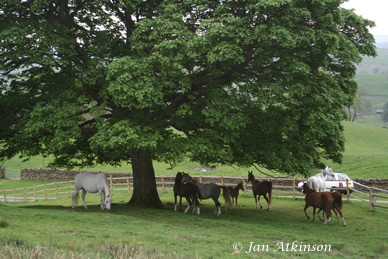
Hanson (grey, by the car) with mares, foals
and yearling colt
The result is that we live with gentle, beautiful horses. Starting ridden work
is an extension of their handling rather than "breaking". The youngest (lightest)
child was always the first in a youngster's saddle. It's a matter of mutual
trust ...
Since any foal may be chosen to stay permanently, all have the same upbringing.
The results have delighted our purchasers in the past, and will in the future.
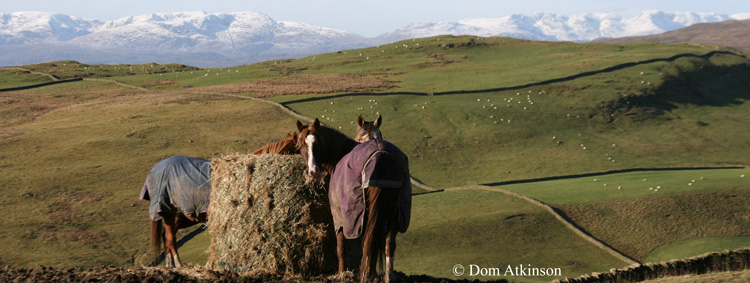
The bachelor herd getting some serious eating done in the winter sunshine,
relaxing in the long view of the first snow of 2012/13 on the Coniston fells, the Langdales and
Scafell Pike.
Video in context (same clip as reached by the links at the top of
the page)
Many of our visitors from all around the world admit towards the end of their
visits that they
came with at least the half intention of proving to themselves that we are wrong. All
have left knowing that we are not wrong, with many asking themselves
whether they can use some of what they have seen for their own horses. We now offer structured courses here in herd behaviour and ethology,
as well as welcoming informal visits as before. During the courses, we can give very detailed descriptions and explanations of what is happening
as it happens<, as well as the benefits of the
situations and interactions.
The photo below caused
quite a stir when we put it onto facebook, as so few people have seen a foal
living together in a family group with the sire and dam:
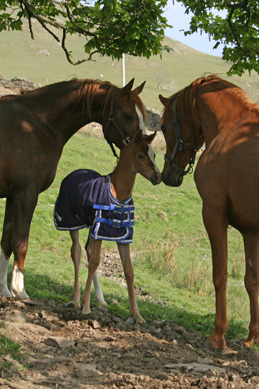
For more on ethology and courses CLICK HERE.
Return to Top
I wandered lonely as a cloud
That floats on high o'er vales and hills,
When all at once I saw a crowd,
A host of colts, serene as fill(ie)s
Beside the stream, beneath the trees,
Playing and dancing in the breeze.
There's a rumour, which we are trying hard to
start, that our lakeland neighbour William Wordsworth drafted
those words after climbing our hill, only to be told that it didn't rhyme
properly and noone would believe it anyway. It might work with some tweaking; And so, Daffodils.
From 2015 we are offering a limited number of places for weanling colts
from other studs to join our own foals until the autumn of their yearling or 2-year-old year. Each
colt will be
integrated into our nursery herd, then later with ours into a mixed herd of
mares and other youngsters. At
the individually, ethologically appropriate time, he will then move to join
the bachelor herd. At the end of the contract, he will return to his owner.
This service allows him to develop into the horse he can become, before a
decision is taken on his future. Once he's gelded, there's no going back.
But why, on balance, not just stick with the herd and carry on doing what has
work that shows us how to give entire males the same quality of
socialisation as females and neuters. This leads to them behaving in equally acceptable ways.
Since 1993 we have had at least one entire male, stallion or colt; and
from 1995 always more than one, including at least one stallion. We soon
found that living in a herd they are much happier and easier to handle, but
we were always careful to avoid the dreaded
face-to-face meeting of entires.
In 1997, Hanson was introduced to his new colt foal. The instant calm showed us that a full stallion could coexist with junior
entires without certain doom for any horses or humans. We had already shown in 1996 that juniors could do it, in a three
colt group of 3 y.o., 2 y.o. and yearling.
In 2005 we began to take people into our herds to show how and why we do
things, and to meet the horses including stallions and colts. Since 2010 we
have taught structured courses here in horse behaviour and ethology.We believe we
should keep them like this, and have built on it
ever since. We love keeping multiple stallions and colts, either herded with
mares and young stock, or in bachelor herds. Our experience is that colts raised in this way are as amenable as
fillies and geldings, and grow into stallions who are kinder, more responsive and
safer in the presence of people and other horses when compared with
"conventionally"Â raised entires.
There is another, very serious purpose in this. With a dwindling gene pool, the future of pure OE, GSB and Crabbet
breeding is in jeopardy. There are few mares of breeding age left. How many
available stallions are there? Time and time again we hear that a colt has
to be gelded because it is not fair, practical or safe to keep him entire.
However, having seen other people's incidents and near misses with colts and
stallions, the approach comes with three very clear warnings from our
experience:
Ethologically based raising and keeping of colts and stallions mustn't begin
on a whim. You can't "just do it" without proper planning and preparation;
Colts and stallions already raised in un-ethological regimes will have
so-called "typical colt/stallion" characteristics, taking longer to adjust, if ever;
Progress towards paradise has to be appropriate in structure and pace. Getting it wrong leaves you in a
harder place, not back where you started.
Return to Top
Winged Saint Coverings
Saint's two 2010 home coverings
also achieved confirmed pregnancies.
Sadly, Canopus twinned yet again after losing her 2009 covering Winged Saint twins 28 days before they
were due. An attempt to reduce her to one single pregnancy failed: she lost
them both and then refused to come back into season for the rest of the year.
We hoped that she would at last conceive a straightforward single
in 2011, but she had her fatal accident before being covered.
On the other hand, Shadowed Gold had a single pregnancy, this time a filly as you can
see clearly from the ultrasound scan:
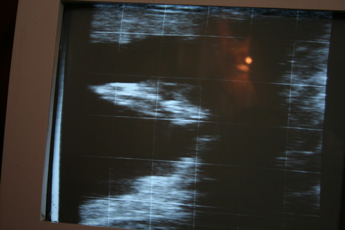
Seren Golden Wings (Winged Saint x Shadowed Gold), chestnut
filly 2011, ultrasound scanned at 61 days gestation.
(Actually, we couldn't see how it shows she is a filly,
either. We also have an annotated copy that makes it oh so clear when you are
shown where to look and what to look at...)
(And notice a reflection in the scanner screen: no, the chestnut isn't the foal at all.
It must be Silihah watching the scanning!)
One of Saint's 2010 visiting mares emerged from her transport in
full season, so ready that we decided to cover her half an hour later. 52 days
after her arrival, she left us with a 50 day confirmed pregnancy.
The other 2010 visiting mare, who has a long history of great difficulty in
breeding, did not conceive. As part of the drive to preserve 100% Crabbet lines,
we are happy to accept "difficult breeding mares", though they may
distort our success rate statistics as in this case.
Our breeding emphasis in 2009, 2010 and 2011 was the Hanif / Sherilla
programme, and we used Saint just enough to safeguard his lines.
His three 2009 coverings produced a superb colt for us, Seren Winged Shadow out
of Shadowed Gold, and a filly for Rebecca Kinnarney out of Seren Capella.
Meanwhile Halal had his first AI pregnancy
in a mare in Wales, and a super foal resulted in 2010.
Return to Top
April, 2012. Seren Capella, daughter of
Hanson, owned and ridden by Rebecca
Kinnarney successfully competed for the Endurance GB team representing Great Britain at
Mont le Soie, Belgium. Rebecca and Capella completed the course, one of only 7
finishers out of 22 starters in the 120km FEI**. The GB team had 4 of the 7 finishers,
and 2 Young Riders (YR) also completed the 120km FEIYRJ** with YR Cari Ann Dark
coming 5th in the 160km FEI***. These are superb
results for the team and the individuals. Huge congratulations to Rebecca
and Capella, their
crew Sarah and Sarah, and the whole team.
During the summer, we were emailed by the owner of another of
"our" horses, Shaiman, trying to find out more about him. We
had lost contact with him in 2006. He has re-emerged as the ride of Amy
Lennon, placed 3rd in the EGB 2012 young rider national championship at King's
Forest. We hope to meet Amy and Shaiman soon, to catch up with him and to
see what we can do for them!
In 2013, Seren Rigel progressed from novice to open with
Rebecca Kinnarney,
and should continue his development in 2014. The steady progression is to
ensure that he reaches his potential without the damage to his health that over
ambitious programmes can cause to horses. Meanwhile, Serinah started her
endurance career with Vivienne Knight. At the end of the year we heard the
standings of both of "our" novices:
Seren Rigel won the Cromwell EGB Group 2013 Novice High Points trophy;
Serinah came second in the Northumberland and Tyneside
Group 2013 Newcomers trophy and second in the Barefoot trophy. Our
congratulations to both teams.
We welcome older mares as well as young, "easier
breeders". Our equine vet Jane King and her team from North West Equine
Vets have and deserve our admiration
for the way she has helped us to breed some superb youngstock out of some very
challenged mares over the years. She works closely with us to achieve and support pregnancies,
with many of our home foals being out of aging "difficult" breeders,
whose lines might otherwise have been lost.
Return to Top
Mares must be of good quality; in good health apart from
any injuries which do not affect their ability to breed, foal or nurse; and with up-to-date
vaccinations and certificated current clear test results for CEM, EVA and strangles
in accordance with the guidelines issued by the HBLB and BEVA. We require that your vet
certifies that your mare has been on premises free from contagious and infectious
diseases for the 60 days prior to her travelling to our premises. These are
routine procedures for your vet, and also ensure that your mare is safe from
infections which could otherwise be brought in by others.
We keep an eye on the situation with respect to EIA
since the outbreak of 2010. There were two cases in Cornwall and Devon in
October 2012, but the outbreak was declared closed by DEFRA on 1st February
2013, and we are therefore not asking for negative EIA test results
from mares who have not been outside the UK. We will reinstate the requirement
with immediate effect if there is another outbreak in the UK. Mares from outside the
UK must be tested for EIA and the original
certificates seen by us before they commence travel to the UK. They will
also be retested for EIA on arrival here and quarantined until the results are
received by us. These tests and quarantine are at the owner's expense.
More information
on EIA is available on the DEFRA website.
As in previous years, our own stallions will have clear test
results for CEM, EVA, and EIA for the 2020 season before any visiting mare travels to us, and
before we begin to dispatch chilled semen.
All of these diseases and their tests
are routine considerations, and there is no need for alarm. However,
good health means both awareness and management of risk.
We will want to know your future plans for the foal before accepting
your mare. We fully endorse the BHS responsible breeding campaign, while keeping
the cost of breeding affordable.
Mares are accepted for covering and livery at the owner's risk.
For safety reasons, we need them to be un-shod front and rear.
SCID, CA and LFS
All of our stallions
have tested clear (N/N) of SCID, LFS and CA.
SCID, CA and LFS information and advice pages will be available shortly
in the public section of our advice pages.
Covering arrangements:
If the mare is violent during covering attempts,
we reserve the right to change from natural covering to AI where AI is available.
We reserve the right to terminate the covering agreement if the mare is violent
and AI is not available.
We can do any covering style and care package, but prefer a first covering on sand & rubber. This
allows us to rescue the stallion if the mare turns out to be violent. We don't
do "cover on sight" as it can teach the stallion to be insistent, and because the young stallions will be
ridden regularly on public roads and in the company of mares in the future.
Instead we prefer a gradual introduction before she is in season, then a
civilised courtship, then the first covering. We are set up to intervene at any stage
to prevent either from having a nasty time.
Drive-by mares can only be covered by AI, as we have no way
of assessing the risk they pose to the stallion during a natural covering.
Covering and Livery Fees, Travel-distance related discount and carbon offsetting:
Our standard stud
terms are NFFR 48; The fee is calculated on an individual basis, to ensure
that mare owners know exactly what the normal cost will be. The fees should then only
rise if a mare requires more than the agreed package, i.e she needs to stay more than 70
days (10 weeks) if she is a visiting mare; or she requires AI rather than
natural covering if she is a visiting mare other than a "drive-by"; or she
requires more than 3 cycles/4 doses of AI if she is a mare receiving transported
semen elsewhere; or she is a visiting mare and requires more than grass keep and
basic care.
NFFR 48 means: if no live foal (surviving for 48 hours) results
from covering, a return visit by the same mare will be free of covering fee,
but subject to livery fees. The mare must still meet our full health, safety and behavioural
requirements. Loss of the foal as a result of accident or acquired infection
is excluded but may still be considered at our sole discretion. A returning
mare's owner may choose a different stallion standing here in preference to the
original stallion.
Returns by a different mare will not be considered unless the
original mare has been lost through insurable circumstances or it is agreed at
the outset of the agreement.
Nomination fee £50. This secures a
place on the stallion's list. It is not
transferrable to another mare except by our prior permission and is non-refundable
unless in exceptional circumstances. It is transferrable to another of our stallions,
but the timing of the mare's visit must dovetail with pre-existing bookings
for that stallion. It is certainly non-refundable once any covering attempt
has been made.
£7 per extra day handling, grass keep and basic care, use of covering
facilities and scanning stocks as required, plus emergency/contingency use of
loosebox;
Quarantine £15 per day.
"Special arrangements" and hard feed costed individually;
Vet's / farrier's / trimmer's / dentist's
and other professional's fees charged
directly to the mare owner;
All visiting mares must leave our premises by 31st August unless
by arrangement prior to arrival.
Free tree planted here for each 50 miles of double-round-trip
as above for carbon offsetting (they will fuel our central heating in a few
years' time). You may also take a free tree to plant at home.
Please Contact us before
sending nomination fees, as we will want to talk through your plans for the foal and
your stallion choice.
All fees must be paid prior to the mare leaving our premises,
including fees to outside professionals.
Vet packages
The excellent North West
Equine Vets are available here for scanning; for fixed priced scanning and
washout packages; and for mares who need reproductive system treatment rather
than routine AI procedures. All of these maximise the chance of a pregnancy
while keeping the costs under control. For mares with breeding difficulties, we
recommend this from the outset. For mares in the favoured age group with
no history of difficulty, you may prefer to assume all is well and think about a
vet package if she does not conceive in the first one or two cycles. The advice
is to investigate any reason rather than hang on and hope, as resolving issues
is less expensive in the medium and long terms.
Artificial Insemination (AI)
Both of us are qualified, and recognised by DEFRA, as Equine Artificial Insemination
Technicians. Aurilla Gold is available by fresh and chilled
semen from our own collection and processing facility, both
here and by next-day-before-0900 guaranteed, insured special delivery. Seren
Altair, Seren Sadrh abd Dandini are planned to have collection training and semen freezing
soon, after which they will also be available by fresh and chilled.
For mare owners in dire need, chilled
semen can be picked up from us directly. Sunday and Monday inseminations are for
those who enjoy driving... We need to be contacted by 1100hr (11 a.m.) at the
very latest. This lets us organise the collection and processing of the semen in time
to get it away for next day special delivery and insemination. The more notice
we have, the more likely we are to be able to collect and dispatch semen to you.
Advance warning is definitely in your interests as we may otherwise be out with
your chosen stallion on a
distant mountain summit while you plead desperately with the answering service...
Note that our standard charge does not
extend beyond dispatch by Royal Mail Special Delivery. If the timing of
your mare results in your vet calling for semen for a Sunday or Monday delivery,
it is your responsibility to arrange pick up from us by yourself or a courier at
your expense, though our fee is then lower in line with the Royal Mail fee.
Our mare insemination facilities are
long established, and our stallion collection area and semen processing setup
are very successful.
We do not inseminate here with frozen semen, as
the repeated scanning is a procedure that must be carried out by a vet and
is therefore beyond our competence.
Fresh and chilled semen costs for extra collections and assessment, and for
extra dispatch or insemination, are additional to the standard fees (valid
for 2017 - please contact us directly for up-to-date prices):
Collection, processing and insemination here £80
Collection, processing and client/courier collection from here £80
Collection, processing and dispatch by Royal Mail Special Delivery by 0900hr Next Day £105*;
*liable to change if Royal Mail prices for the special Delivery service change.
Replacement charge per shipper if not returned in reusable condition £20.
Vet's fees will be invoiced directly to
the mare owner.
Winged Saint was collected from by the renowned Martin Boyle
at West Kington Stud in the autumn of 2009. We now have a
small amount of good quality frozen semen in store at West Kington that is of commercial quality
and certified for Australia, New Zealand, USA, EC and the UK.
While Halal was with us, we took a very small collection
of frozen semen from him at West Kington, too. Some of this may become available to mares, provided that
we achieve the live foals we are planning to be sired from it for ourselves and subject to the agreement
of his owner, Ali Cox. It is not certified for export from the UK.
Return to Top
Return to Top
This website and all content including images
© 1996 - 2026 Seren Arabians, High House Labradors and High House Centre unless other copyright holder acknowledged.
All rights reserved.
